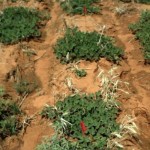|
Maturity. The majority of Texas production has shifted to West Texas over the past decade, where climate poses particular problems. The growing season is shorter and time to maturity is longer. Late-season nighttime temperatures of <50° C reduce daytime CO2exchange rates to <50% of optimal, and fruit maturation ceases even though daytime temperatures may be considerably higher. Rapid drying of an immature crop under hot days can result in poor flavor characteristics. Maturity is difficult to estimate in peanut because time to flowering is not a useful indicator of maturity, and because direct observation of pod maturity is not possible without harvesting the plant. Therefore, multiple diggings and evaluations are needed around harvest time. Because early maturity means fewer days for photosynthesis, a correlation between early maturity and reduced yield can be expected. Therefore, it will be necessary to employ strong selection for both traits.Seed oil content. Seed oxidative stability is associated with oil content. The two predominant oils in the peanut seeds are the monounsaturated 18:1 oleic acid and 18:2 linoleic acid. Oleic acid is significantly more stable to oxidation than is linoleic acid. Typical O/L ratios are 1.7 to 1.8; however, in West Texas, this figure is about 1.2 to 1.3, resulting in a tendency towards rancidity before the end of shelf life for peanuts grown elsewhere. This also contributes to the perception of inferior seed quality. High-O/L peanut lines can significantly improve shelf life, and contain high levels of the monounsaturated oil oleic acid, associated with reduced coronary artery diesase and present in olive and canola oils. Two high O/L peanut varieties are being released by Dr. Charles Simpson(TAES – Stephenville). These are the runner variety ‘TamRunOL-01’ and the Spanish variety ‘OLin.’For best results, early maturity and high O/L traits need to be combined into a variety. Development of enhanced O/L peanuts is complicated by the genetics of the O/L trait. Although determined to be controlled by two recessive genes in a runner background, one or two major genes govern the trait in Spanish types, and there is evidence that the genetic nature of this trait is more complex and may be quantitative in nature (López et al., 2000). Mutations in delta-12 desaturase genes have been identified, but genetic association between sequence polymorphisms and oil content has not been tested empirically.
Goals The primary goal of the breeding program is to develop earlier-maturing peanuts with high yield, enhanced O/L, and disease resistance (see below). Priority is being given to Spanish and runner types because of their share of the Texas production and time to maturity. We will also attempt to understand better the genetic basis of the high O/L trait to assist in breeding efforts. Research Program and Results Maturity.
|



